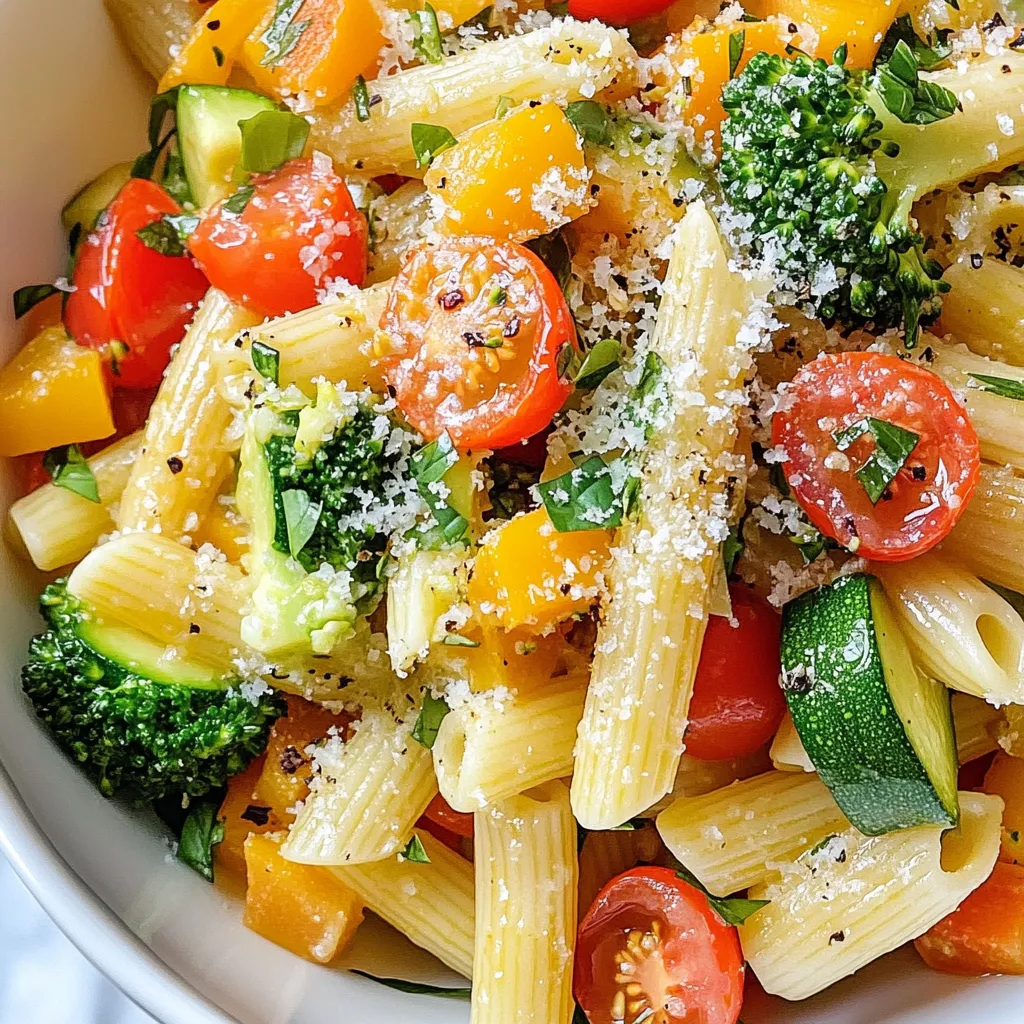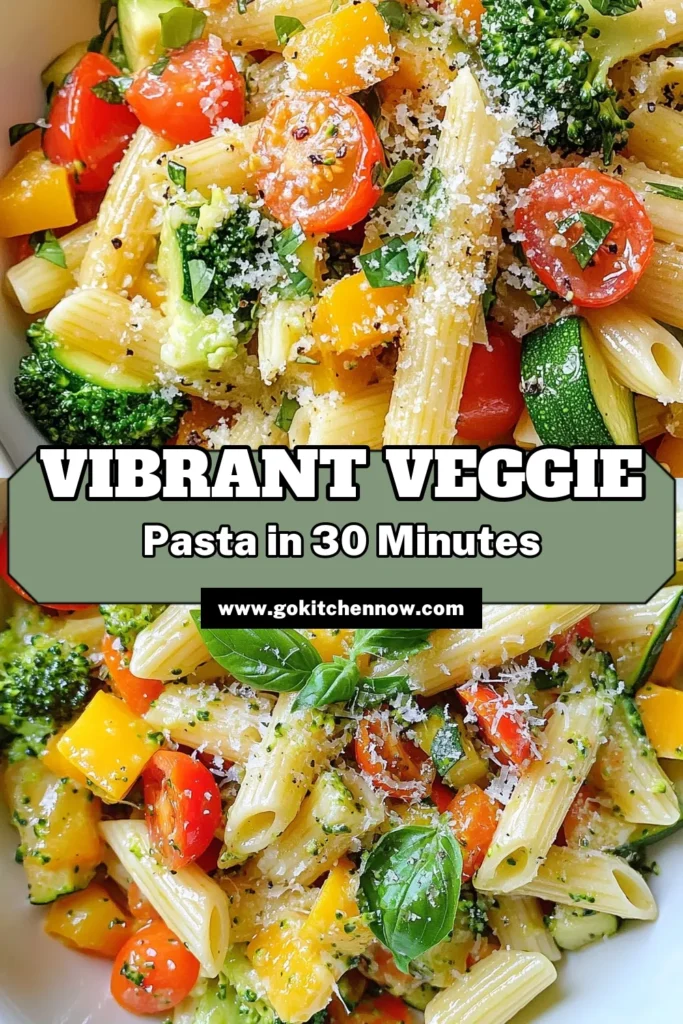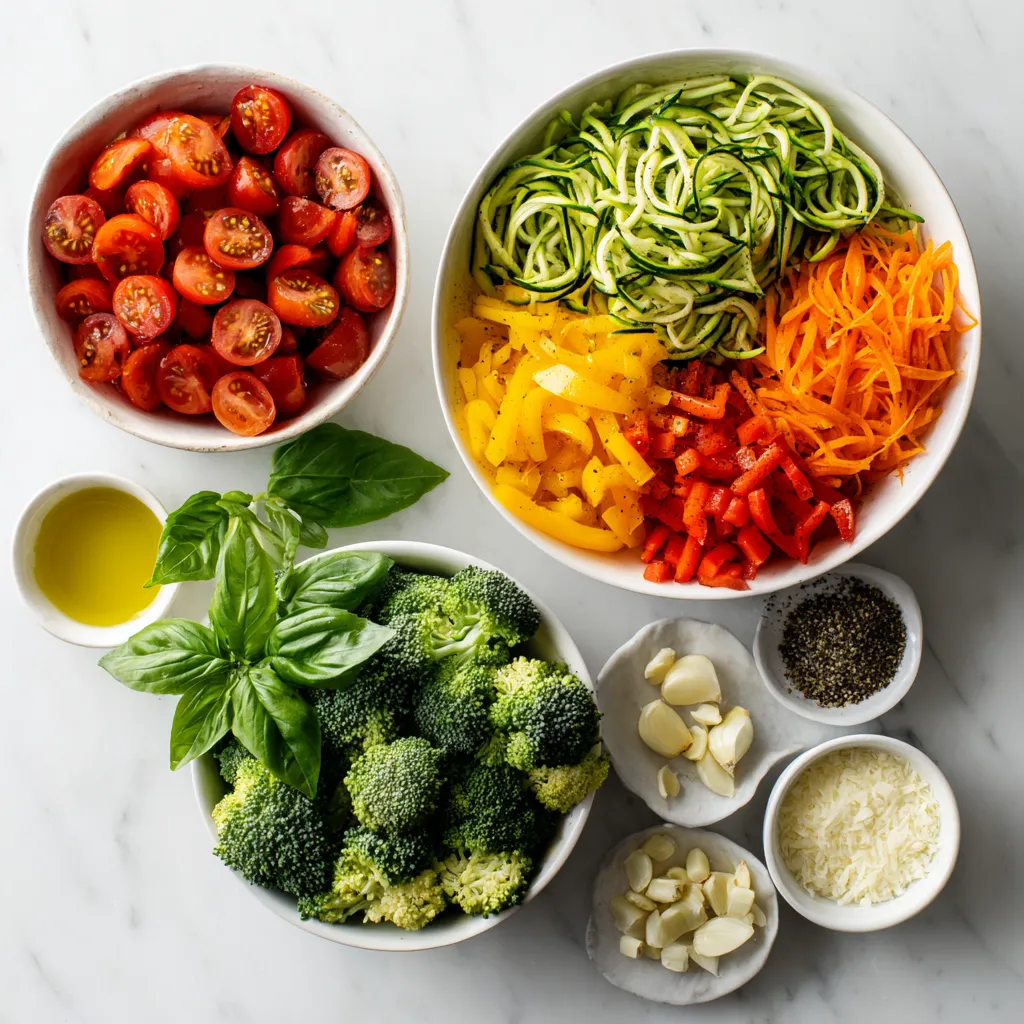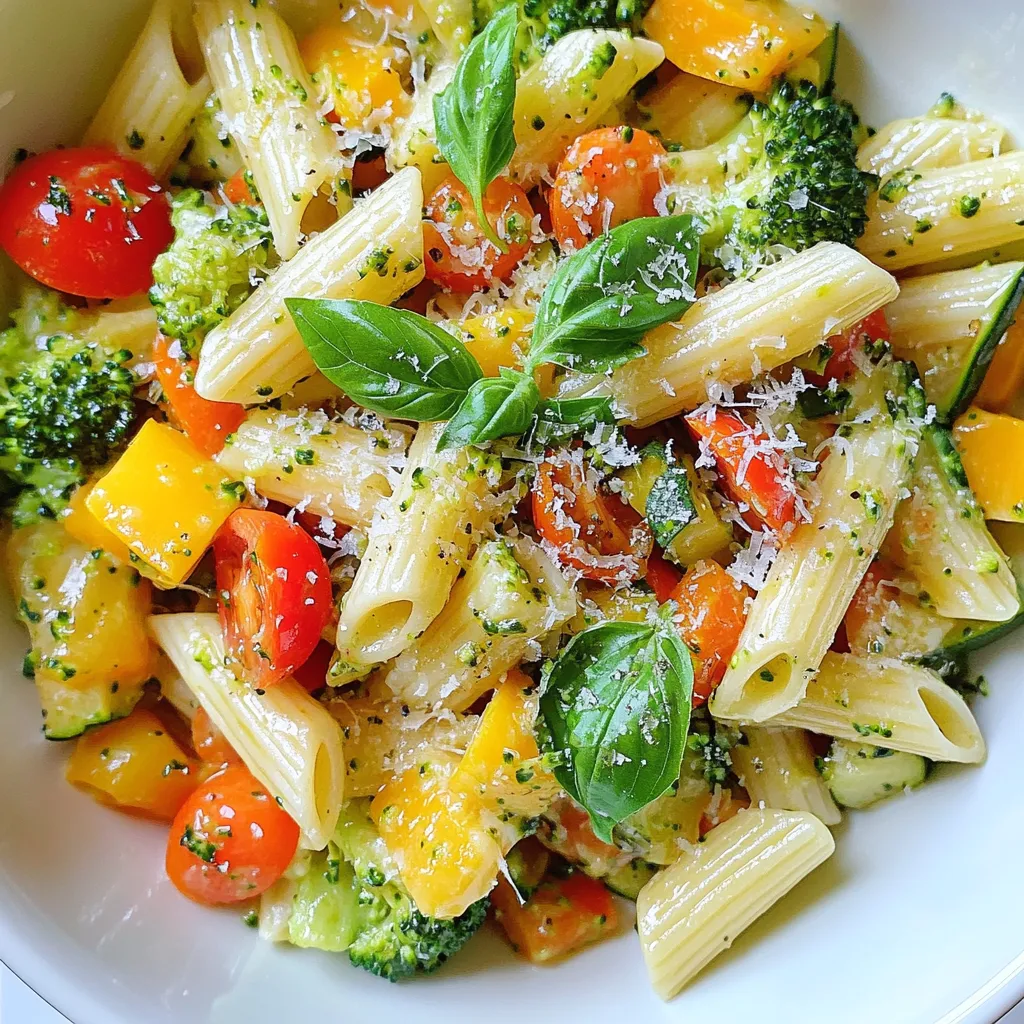WANT TO SAVE THIS RECIPE?
Pasta Primavera is a vibrant and tasty dish that brings together pasta and fresh veggies. You can whip up this colorful meal in no time with a few simple ingredients. From cherry tomatoes to zucchini, this recipe offers a mix of flavors and nutrients. Join me as I guide you step-by-step to create a dish that is not only good for you but also delightful to eat! Let’s dive into the world of Pasta Primavera!

Why I Love This Recipe
- Fresh and Colorful: This recipe showcases a vibrant array of vegetables that not only enhance the dish visually but also provide essential nutrients.
- Quick and Easy: With a total time of just 30 minutes, this pasta primavera is perfect for busy weeknights or last-minute gatherings.
- Customizable: You can easily swap in your favorite vegetables or whatever you have on hand, making it a versatile meal option.
- Deliciously Healthy: This dish is not only satisfying and flavorful but also packed with healthy ingredients, making it a guilt-free indulgence.
Ingredients
List of Ingredients
– 12 oz pasta (penne or fettuccine)
– 1 cup cherry tomatoes, halved
– 1 zucchini, thinly sliced
– 1 bell pepper (any color), julienned
– 1 cup broccoli florets
– 1 carrot, julienned
– 3 cloves garlic, minced
– 1/4 cup olive oil
– 1 teaspoon dried Italian herbs (basil, oregano, thyme)
– Salt and pepper to taste
– Fresh basil leaves for garnish
– Grated Parmesan cheese, to serve (optional)
Pasta Primavera shines with fresh, vibrant ingredients. The choice of pasta helps hold the sauce and veggies. I love using penne or fettuccine for their great texture.
Cherry tomatoes add a sweet burst of flavor. Zucchini brings a nice crunch, while bell pepper adds color and taste. Broccoli florets offer a slight bitterness that balances the dish. Carrots add sweetness and a lovely orange hue.
Garlic is key for flavor. It gives a warm, rich taste. Olive oil adds richness and helps to sauté the veggies. The dried Italian herbs tie everything together with classic flavors.
Don’t forget the salt and pepper. They enhance all the other tastes. Fresh basil leaves add a bright finish, while grated Parmesan offers a creamy touch if you choose to add it.
This dish is all about using fresh, seasonal ingredients. Choose what you love and make it your own!

Step-by-Step Instructions
Cooking the Pasta
– Bring a large pot of salted water to a boil.
– Add 12 oz of pasta and cook until al dente. This usually takes about 8-10 minutes.
– Reserve 1/2 cup of the pasta cooking water, then drain the pasta. Set it aside in a large bowl.
Sauté the Garlic and Vegetables
– In a large skillet, heat 1/4 cup olive oil over medium heat.
– Add 3 cloves of minced garlic and sauté for about 1 minute until it smells great.
– Next, add 1 zucchini (thinly sliced), 1 bell pepper (julienned), 1 cup of broccoli florets, and 1 carrot (julienned).
– Sauté these veggies for about 5-7 minutes. You want them tender, but still crisp.
Combine with Pasta
– Stir in 1 cup of halved cherry tomatoes and cook for 2-3 minutes until they soften.
– Add the cooked pasta to the skillet.
– Pour in the reserved pasta water and sprinkle in 1 teaspoon of dried Italian herbs.
– Toss everything together until well mixed and heated through.
– Season with salt and pepper to taste.
– Remove from heat and garnish with fresh basil leaves. Serve hot with grated Parmesan cheese if you like.
Tips & Tricks
Cooking Tips
Cooking pasta to al dente is key. Al dente means the pasta is firm but not hard. It gives texture and holds sauce well. To achieve this, boil salted water, and cook the pasta just until it has a slight bite. Always check the package for timing.
To sauté vegetables properly, use medium heat. Heat the olive oil first, then add minced garlic. This brings out flavor. After a minute, add your vegetables. Stir frequently but do not overcrowd the pan. You want them to be tender yet crisp.
Serving Suggestions
For a beautiful presentation, use large bowls. After plating, add a sprinkle of fresh Parmesan on top. This adds a nice touch. A few extra basil leaves will brighten the dish. Drizzle some olive oil for extra flavor and shine.
Pair Pasta Primavera with a crisp white wine like Pinot Grigio. It complements the vegetables nicely. If you prefer bread, a fresh baguette works well. It’s perfect for soaking up any sauce.
Garnishing Ideas
Garnishes can change the look of your dish. Fresh herbs, like parsley or basil, add a pop of color. You can also sprinkle some grated cheese on top. It introduces a savory flavor.
For visual appeal, consider colorful vegetables. Red bell peppers, green zucchini, and yellow carrots create a vibrant plate. The mix of colors makes the dish more inviting and fun.
Pro Tips
- Use Seasonal Vegetables: Opt for vegetables that are in season to enhance flavor and nutrition. This will also make your dish more vibrant and colorful.
- Perfect Pasta Cooking: Always cook pasta in a large pot of salted water to ensure even cooking and optimal flavor. Al dente pasta holds up better when tossed with sauce.
- Customize Your Herbs: Feel free to experiment with different herbs like parsley or thyme based on your preference. Fresh herbs can be added at the end for a burst of flavor.
- Presentation Matters: For a restaurant-style presentation, twirl the pasta into nests on the plate and top with vegetables and a sprinkle of cheese for an appealing look.

Variations
Ingredient Substitutions
For Pasta Primavera, you can switch up the pasta. Try using gluten-free pasta made from rice or quinoa. It’s just as tasty! You can also choose different vegetables based on the season. In summer, add fresh corn or peas. In fall, consider using butternut squash or Brussels sprouts.
Flavor Enhancements
To make this dish even better, add some protein. Grilled chicken, shrimp, or tofu works well. You can also spice it up! A pinch of red pepper flakes adds heat. A bit of lemon zest gives a bright flavor that pops.
Vegan and Dietary Adjustments
If you want to make this dish vegan, skip the cheese. Use nutritional yeast for a cheesy flavor instead. For nut-free diets, keep an eye on ingredients like tofu that may contain nuts. You can also swap regular pasta for zucchini noodles for a low-carb option. This keeps it light and fresh!
Storage Info
Storing Leftovers
To store Pasta Primavera, let it cool first. Use an airtight container. This keeps the dish fresh. You can keep it in the fridge for up to three days. For best taste, eat it soon. If you want to freeze it, use freezer-safe containers. It will last for about two months. Make sure to label the containers with the date. This way, you know when to use them.
Reheating Instructions
When it’s time to eat the leftovers, you can reheat them. The best way is to use a skillet. Add a splash of water to keep it moist. Heat over medium-low heat for about five minutes. Stir often to avoid sticking. You can also use the microwave. Place the pasta in a bowl and cover it. Heat it for one minute, then stir. Repeat until warm. This helps keep the texture and flavor nice.
Shelf Life
Leftovers of Pasta Primavera last for three days in the fridge. In the freezer, they can last for up to two months. Always check for signs of spoilage before eating. If it smells bad or looks odd, throw it away. Enjoy your colorful dish while it’s fresh!
FAQs
What is Pasta Primavera?
Pasta Primavera is a fresh and colorful pasta dish. It originated in Italy. The name means “spring pasta” in Italian. It celebrates the fresh veggies of spring. Chefs crafted it in the 1970s in New York. It quickly became popular for its lightness and bright flavors. You can enjoy it as a main dish or a side.
Can I use other vegetables in Pasta Primavera?
Yes, you can switch up the veggies! Seasonal vegetables work well. Try asparagus, peas, or spinach for spring. In summer, add eggplant or bell peppers. Fall brings squash or mushrooms. Use what you love or what you have. This dish is versatile and fun to customize.
How can I make Pasta Primavera healthier?
To make Pasta Primavera healthier, consider these tips:
– Use whole grain pasta for more fiber.
– Add more veggies to boost nutrients.
– Swap olive oil for a lighter cooking spray.
– Use less cheese or skip it for fewer calories.
– Add lean protein like grilled chicken or chickpeas for balance.
These changes keep the dish tasty while enhancing its health benefits.
This blog post covered a tasty Pasta Primavera recipe. You learned about the ingredients and step-by-step cooking tips. I shared helpful storage advice and answered common questions. Remember, you can swap ingredients to fit your diet or use seasonal veggies.
Final thoughts: Pasta Primavera is flexible, healthy, and full of flavor. Give it a try and enjo
Pasta Primavera Delight
A vibrant and fresh pasta dish loaded with colorful vegetables and herbs.
Prep Time 15 minutes mins
Cook Time 15 minutes mins
Total Time 30 minutes mins
Course Main Course
Cuisine Italian
Servings 4
Calories 350 kcal
- 12 oz pasta (penne or fettuccine)
- 1 cup cherry tomatoes, halved
- 1 medium zucchini, thinly sliced
- 1 medium bell pepper (any color), julienned
- 1 cup broccoli florets
- 1 medium carrot, julienned
- 3 cloves garlic, minced
- 1 4 cup olive oil
- 1 teaspoon dried Italian herbs (basil, oregano, thyme)
- to taste salt and pepper
- for garnish fresh basil leaves
- to serve grated Parmesan cheese (optional)
In a large pot, bring salted water to a boil and cook the pasta according to package instructions until al dente. Reserve 1/2 cup of the pasta cooking water, then drain the pasta and set aside.
In a large skillet, heat the olive oil over medium heat. Add the minced garlic and sauté for about 1 minute until fragrant.
Add the zucchini, bell pepper, broccoli, and carrot to the skillet. Sauté for about 5-7 minutes until the vegetables are tender but still crisp.
Stir in the halved cherry tomatoes and cook for another 2-3 minutes until they start to soften.
Add the cooked pasta to the skillet along with the reserved pasta water and dried Italian herbs. Toss everything together until well combined and heated through. Season with salt and pepper to taste.
Remove from heat and garnish with fresh basil leaves. Serve hot with grated Parmesan cheese on the side if desired.
Serve the pasta in large bowls, garnished with a sprinkle of freshly grated Parmesan and a few extra basil leaves for a pop of color. Drizzle a little olive oil on top for added richness.
Keyword healthy, Italian, pasta, vegetables
WANT TO SAVE THIS RECIPE?





